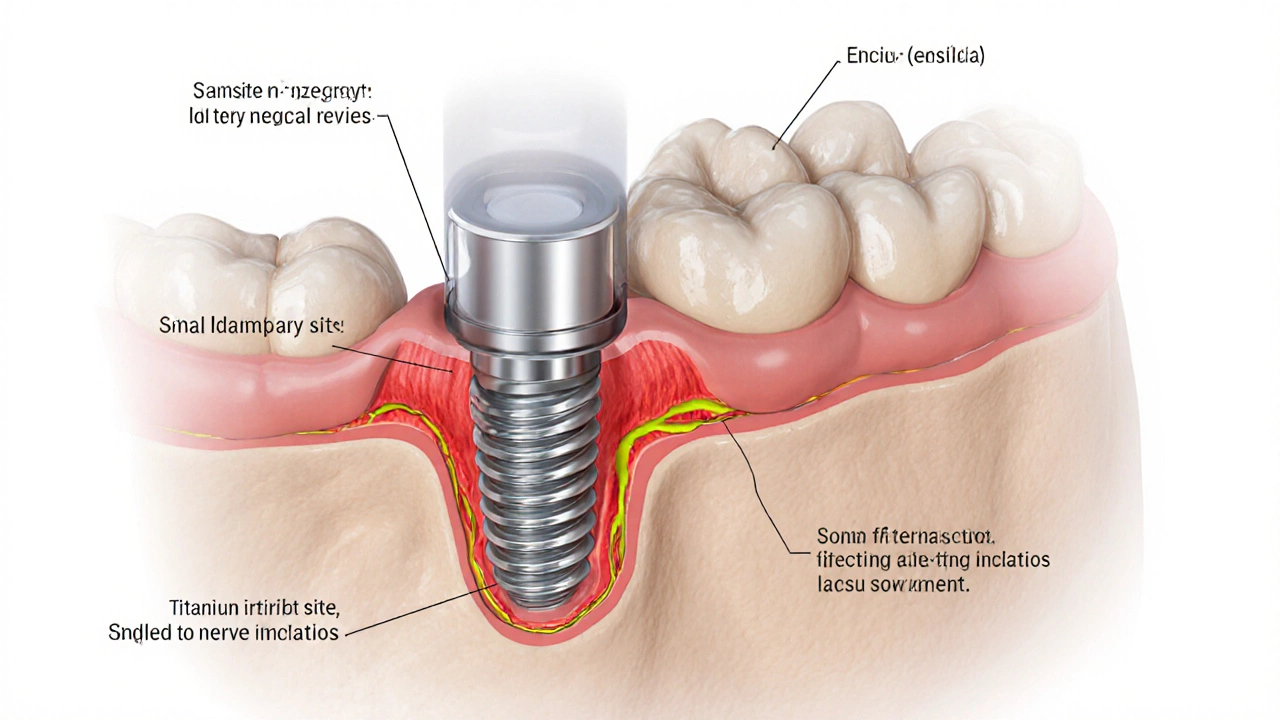
Dental Implant Cost Calculator
Cost Estimator
Estimate your total dental implant costs in the UK.
Estimated Cost Breakdown
Enter values to see your estimate
Total Estimated Cost:
Based on UK pricing from article. Includes:
- Implant fixture
- Surgical fees
- Bone graft/sinus lift (if applicable)
- Crown/abutment
Important: This estimate does NOT include:
- Follow-up appointments
- Insurance coverage
- Future maintenance or replacements
- Medications or pain management
When you hear about dental implants, the first thing that comes to mind is often a permanent, natural‑looking replacement for missing teeth. But every solution has a flip side, and implants are no exception. Below we unpack the main downsides-medical, financial and practical-so you can weigh them against the benefits before deciding.
Quick Summary of Implant Downsides
- Potential surgical complications such as infection or nerve damage
- High upfront cost and possible hidden fees
- Lengthy healing period that may delay the final restoration
- Risk of implant failure or bone loss over time
- Maintenance demands and possible long‑term gum issues
What Is a Dental Implant?
Dental implants are titanium or zirconia fixtures surgically placed into the jawbone to act as artificial tooth roots. Once the metal post integrates with the bone-a process called osseointegration-a crown, bridge or denture snaps onto it, restoring function and aesthetics.
Medical Risks and Complications
Even though implant surgery is routine, it carries real medical risks:
- Infection: The surgical site can become infected if bacteria enter during or after the procedure. Infections may require antibiotics or even removal of the implant.
- nerve injury: Improper placement near the inferior alveolar nerve can cause temporary or permanent numbness, tingling, or pain in the lower lip and chin.
- Sinus perforation: Upper‑jaw implants that extend into the sinus cavity may cause sinusitis or chronic drainage. A sinus lift surgery can mitigate this, but adds cost and recovery time.
- Bone loss: If the implant fails to fuse properly, the surrounding jawbone can resorb, leading to further instability and the need for additional grafting.
- Gum disease: Poor oral hygiene can trigger peri‑implantitis-an inflammatory condition that erodes the bone and gum tissue around the implant, mirroring periodontitis around natural teeth.
Financial Downside: Costs You Might Not Expect
Dental implants are often advertised as a one‑time fix, but the price tag can be surprising:
- Implant fixture: £1,500‑£3,000 per unit in the UK.
- Surgical fees: £500‑£1,200 for the extraction and placement.
- Bone graft or sinus lift: £700‑£2,500 if your jawbone isn’t thick enough.
- Crown or abutment: £600‑£1,200.
- Follow‑up appointments: Multiple check‑ins over months add up.
When you total everything, a single implant can cost between £3,000 and £5,500. Insurance coverage in the UK is limited, so many patients pay out‑of‑pocket.

Recovery Time and Lifestyle Impact
Compared to a removable denture, an implant’s healing phase is lengthy:
- Immediate post‑op swelling and bruising last 3‑5 days.
- Soft‑diet restrictions stay in place for 2‑4 weeks.
- Osseointegration can take 3‑6 months before the crown is attached.
- Full functional loading may not be possible until 6‑12 months, especially if bone grafts were needed.
During this period, you’ll need to avoid certain foods, manage pain medication, and possibly miss work or social events.
Long‑Term Maintenance and Potential Failure
Even after the crown is placed, implants are not “set and forget.” Regular dental visits are essential. Over time, complications can arise:
- Mechanical wear: Screws can loosen, crowns can chip, and the prosthetic may need replacement every 10‑15 years.
- Biological failure: If peri‑implantitis progresses, the implant may need removal, returning you to the original problem of missing teeth.
- Adjacent tooth damage: Incorrect placement can stress neighboring teeth, leading to cracks or cavities.
Comparing Implant Downsides with Other Tooth‑Replacement Options
| Aspect | Dental Implants | Dental Bridge | Dentures |
|---|---|---|---|
| Initial Cost (UK) | £3,000‑£5,500 per tooth | £1,200‑£2,500 per unit | £500‑£1,500 total |
| Surgical Invasiveness | High - requires bone drilling | Medium - tooth preparation | Low - no surgery |
| Healing Time | 3‑12 months | 1‑2 weeks | Immediate |
| Long‑Term Maintenance | Regular clean‑ups + possible grafts | Potential decay of supporting teeth | Daily removal, adhesive issues |
| Risk of Bone Loss | Yes, if implant fails | No direct bone loss | Accelerates jaw resorption |
| Potential for Nerve Damage | Yes, especially lower jaw | Rare | None |

How to Minimize the Downsides
Knowing the risks lets you take steps to avoid them:
- Choose an experienced surgeon: Look for a dentist or oral surgeon with at least 200 successful placements.
- Get a full 3‑D scan: Cone‑beam CT imaging reveals bone density, nerve location and sinus proximity before you go under.
- Maintain impeccable oral hygiene: Brush twice daily, floss, and use an antibacterial mouthwash to prevent peri‑implantitis.
- Plan finances ahead: Ask for a detailed, itemized quote and explore NHS referral options or private payment plans.
- Follow post‑op instructions: Soft diet, prescribed antibiotics, and scheduled check‑ups reduce infection risk.
Checklist: Is an Implant Right for You?
- Do you have sufficient jawbone volume? (If not, bone graft may be needed.)
- Are you a non‑smoker? Smoking increases failure rates up to 30%.
- Can you afford the total cost, including possible future repairs?
- Are you comfortable with a 3‑6 month healing period?
- Do you have a reliable dentist for long‑term maintenance?
If you answered “yes” to most of these, the benefits may outweigh the downsides. If several answers are “no,” consider a bridge or high‑quality denture instead.
Frequently Asked Questions
Can a dental implant fail completely?
Yes. Failure can occur if the implant does not osseointegrate, becomes infected, or suffers trauma. In such cases the fixture may need removal and the site re‑treated.
How long do implants usually last?
With good oral care, implants can last 20‑30 years or more. The prosthetic crown, however, often needs replacement after 10‑15 years.
Is the implant procedure painful?
Local anesthesia makes the surgery itself pain‑free. Post‑op soreness is typical and can be managed with over‑the‑counter painkillers.
Do implants affect speech?
Initially, the swollen gums and temporary prosthetic may make speech sound slightly different, but most people adapt within a few days.
Can I get implants if I have gum disease?
Active gum disease must be treated first. Untreated periodontitis raises the risk of peri‑implantitis and implant failure.
Understanding the possible downsides helps you set realistic expectations and avoid costly surprises. Talk to a qualified dental professional, weigh the numbers, and decide whether the long‑term benefits of a stable, natural‑looking tooth outweigh the upfront challenges.